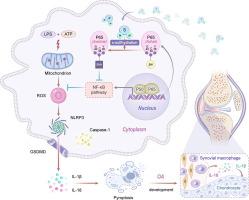当前位置:
X-MOL 学术
›
J. Adv. Res.
›
论文详情
Our official English website, www.x-mol.net, welcomes your
feedback! (Note: you will need to create a separate account there.)
GYY4137-induced p65 sulfhydration protects synovial macrophages against pyroptosis by improving mitochondrial function in osteoarthritis development
Journal of Advanced Research ( IF 11.4 ) Pub Date : 2024-06-04 , DOI: 10.1016/j.jare.2024.05.033 Jun Ma 1 , Peng Yang 2 , Zhibin Zhou 3 , Tengfei Song 4 , Liang Jia 5 , Xiaofei Ye 6 , Wei Yan 7 , Jiuyi Sun 7 , Tianwen Ye 4 , Lei Zhu 4
中文翻译:

GYY4137诱导的 p65 硫酸化通过改善骨关节炎发展中的线粒体功能来保护滑膜巨噬细胞免受焦亡
骨关节炎 (OA) 是最常见的关节炎,其特征是进行性滑膜炎症和关节软骨丢失。尽管 GYY4137 是一种新型的缓释硫化氢 (H2S) 供体,具有强大的抗炎特性,可能调节 OA 的进展,但其潜在机制仍不清楚。
在这项研究中,我们验证了 GYY4137 对 OA 病理过程的保护作用,并阐明了其潜在的调节机制。
在原代小鼠软骨细胞或小鼠巨噬细胞系原始 264.7 中进行细胞转染、免疫荧光染色、EdU 测定、透射电子显微镜检查、线粒体膜电位测定、电泳迁移率变化测定、硫酸化测定、qPCR 和 western blot 测定用于体外研究。DMM 诱导的 OA 小鼠模型和 C57BL/6 背景上的巨噬细胞特异性 p65 敲除 (p65f/f LysM-CreERT2) 小鼠进行体内研究。
我们发现 GYY4137 可以通过抑制体内滑膜焦亡来缓解 OA 进展。此外,我们的体外数据显示,GYY4137减弱炎症诱导的 NLRP3 和 caspase-1 激活,并导致巨噬细胞中 IL-1β 的产生减少。从机制上讲,GYY4137响应炎症刺激而增加 NF-kB p65 的过硫化,导致细胞活性氧 (ROS) 积累减少并改善线粒体功能障碍。使用定点诱变,我们发现 H2S 过硫化物在 p65 蛋白中使半胱氨酸 38 受损并阻碍 p65 转录活性,而 p65 突变体损害巨噬细胞对 GYY4137 的反应。
这些发现表明了一种机制,即 GYY4137 通过 p65 的氧化还原修饰参与抑制 OA 的 NLRP3 激活以调节炎症反应。因此,我们提出 GYY4137 代表了一种有前途的新型治疗策略,用于治疗 OA。
更新日期:2024-06-04
Journal of Advanced Research ( IF 11.4 ) Pub Date : 2024-06-04 , DOI: 10.1016/j.jare.2024.05.033 Jun Ma 1 , Peng Yang 2 , Zhibin Zhou 3 , Tengfei Song 4 , Liang Jia 5 , Xiaofei Ye 6 , Wei Yan 7 , Jiuyi Sun 7 , Tianwen Ye 4 , Lei Zhu 4
Affiliation

|
Introduction
Osteoarthritis (OA) is the most common arthritis that is characterized by the progressive synovial inflammation and loss of articular cartilage. Although GYY4137 is a novel and slow-releasing hydrogen sulfide (H2S) donor with potent anti-inflammatory properties that may modulate the progression of OA, its underlying mechanism remains unclear.Objectives
In this study, we validated the protective role of GYY4137 against OA pathological courses and elucidated its underlying regulatory mechanisms.Methods
Cell transfection, immunofluorescence staining, EdU assay, transmission electron microscopy, mitochondrial membrane potential measurement, electrophoretic mobility shift assay, sulfhydration assay, qPCR and western blot assays were performed in the primary mouse chondrocytes or the mouse macrophage cell line raw 264.7 for in vitro study. DMM-induced OA mice model and Macrophage-specific p65 knockout (p65f/f LysM-CreERT2) mice on the C57BL/6 background were used for in vivo study.Results
We found that GYY4137 can alleviate OA progress by suppressing synovium pyroptosis in vivo. Moreover, our in vitro data revealed that GYY4137 attenuates inflammation-induced NLRP3 and caspase-1 activation and results in a decrease of IL-1β production in macrophages. Mechanistically, GYY4137 increased persulfidation of NF-kB p65 in response to inflammatory stimuli that results in a decrease of cellular reactive oxygen species (ROS) accumulation and ameliorates mitochondrial dysfunctions. Using site-directed mutagenesis, we showed that H2S persulfidates cysteine38 in p65 protein and hampers p65 transcriptional activity, and p65 mutant impaired macrophage responses to GYY4137.Conclusion
These findings suggest a mechanism by which GYY4137 through redox modification of p65 participates in inhibiting NLRP3 activation by OA to regulate inflammatory responses. Thus, we propose that GYY4137 represents a promising novel therapeutic strategy for the treatment of OA.中文翻译:

GYY4137诱导的 p65 硫酸化通过改善骨关节炎发展中的线粒体功能来保护滑膜巨噬细胞免受焦亡
介绍
骨关节炎 (OA) 是最常见的关节炎,其特征是进行性滑膜炎症和关节软骨丢失。尽管 GYY4137 是一种新型的缓释硫化氢 (H2S) 供体,具有强大的抗炎特性,可能调节 OA 的进展,但其潜在机制仍不清楚。
目标
在这项研究中,我们验证了 GYY4137 对 OA 病理过程的保护作用,并阐明了其潜在的调节机制。
方法
在原代小鼠软骨细胞或小鼠巨噬细胞系原始 264.7 中进行细胞转染、免疫荧光染色、EdU 测定、透射电子显微镜检查、线粒体膜电位测定、电泳迁移率变化测定、硫酸化测定、qPCR 和 western blot 测定用于体外研究。DMM 诱导的 OA 小鼠模型和 C57BL/6 背景上的巨噬细胞特异性 p65 敲除 (p65f/f LysM-CreERT2) 小鼠进行体内研究。
结果
我们发现 GYY4137 可以通过抑制体内滑膜焦亡来缓解 OA 进展。此外,我们的体外数据显示,GYY4137减弱炎症诱导的 NLRP3 和 caspase-1 激活,并导致巨噬细胞中 IL-1β 的产生减少。从机制上讲,GYY4137响应炎症刺激而增加 NF-kB p65 的过硫化,导致细胞活性氧 (ROS) 积累减少并改善线粒体功能障碍。使用定点诱变,我们发现 H2S 过硫化物在 p65 蛋白中使半胱氨酸 38 受损并阻碍 p65 转录活性,而 p65 突变体损害巨噬细胞对 GYY4137 的反应。
结论
这些发现表明了一种机制,即 GYY4137 通过 p65 的氧化还原修饰参与抑制 OA 的 NLRP3 激活以调节炎症反应。因此,我们提出 GYY4137 代表了一种有前途的新型治疗策略,用于治疗 OA。
















































 京公网安备 11010802027423号
京公网安备 11010802027423号